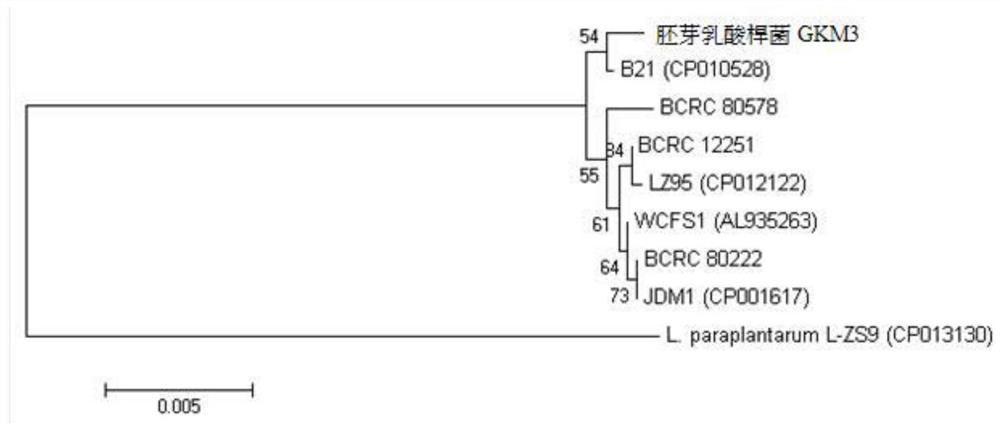Lactobacillus plantarum and its use in lowering blood lipid, liver function index, uric acid and anti-inflammation
A technology for the use of Lactobacillus plantarum, which is applied in the field of Lactobacillus plantarum strains to prevent and/or treat obesity-related diseases, and can solve problems such as inability to meet the needs of relief
- Summary
- Abstract
- Description
- Claims
- Application Information
AI Technical Summary
Problems solved by technology
Method used
Image
Examples
Embodiment 1
[0088] Example 1: collection, separation and purification of strains
[0089] Visit farmers and families engaged in farming in Yilan, Hualien, Taitung and other places, and observe the elderly farmers who are over 75 years old and can still be self-sufficient and cultivate flexibly. It is inferred that the long-term intake of food containing lactic acid bacteria means that long-term exposure to strains with unique prebiotic effects will help elderly farmers maintain good physiological function. Therefore, collect samples that may contain lactic acid bacteria everywhere, store the samples in sealed sterile bags, refrigerate them in the mobile refrigerator and take them back to the laboratory to isolate and purify the probiotic strains contained in the samples. Firstly, prepare the culture medium containing different nutrient sources to screen different kinds of lactic acid strains in the sample. For example, Mrs agar, PCA agar, M17 agar, Rogosa agar, TOS MUP agar, Mrs agar with 3% ...
Embodiment 2
[0091] Example 2: gene analysis and identification of strains
[0092] Firstly, the DNA of gkm3 was collected for sequencing, and the strains were identified by gene comparison. Gkm3 was activated by scribing, and a single colony was inoculated into the culture medium with an inoculation ring. Fresh bacteria were collected the next day, and the strain gDNA was extracted by CTAB method. The gDNA quality was confirmed by 0.6% agar gel electrophoresis. After concentration, the whole genome of the strain was analyzed by the third generation sequencing technology platform pacbio rsii. According to the analysis results of the whole genome, the length of gkm3 whole genome is 3076381bp and contains a 49415bp plasmid (SEQ ID No: 1). The whole genome sequences of gkm3 were compared in the whole genome database, and the sequences of PHEs (SEQ ID No: 2) and recn (SEQ ID No: 3) genes of gkm3 were obtained. Then, the sequences of the PHEs gene (SEQ ID No: 2) of gkm3 were compared in the NCBI da...
Embodiment 3
[0099] Example 3: strain culture
[0100] The effects of different culture conditions on the yield of gkm3 were studied. The carbon source and nitrogen source in the fermentation medium of gkm3 were tested by one factor test.
[0101] Firstly, starting from the demand of carbon source, compare the number of gkm3 colonies and IFN to peripheral leukocyte lymphocytes under the conditions of eight carbon sources: glucose, sucrose, lactose, fructose, mannose, sorbitol, glycerol and molasses- γ Induction ability to select carbon sources with high yield and high physiological activity of gkm3. Add 3wt% of the above eight carbon sources relative to the total weight of the MRS medium, and set the culture temperature at about 37 ℃ and the rotating speed at about 20rpm. The better four carbon sources and the number of viable colonies in the experimental results are shown in Table 2 below. The results show that the highest number of colonies cultured with sucrose is 4.2x10 9 CFU / ml, compare...
PUM
 Login to View More
Login to View More Abstract
Description
Claims
Application Information
 Login to View More
Login to View More - R&D
- Intellectual Property
- Life Sciences
- Materials
- Tech Scout
- Unparalleled Data Quality
- Higher Quality Content
- 60% Fewer Hallucinations
Browse by: Latest US Patents, China's latest patents, Technical Efficacy Thesaurus, Application Domain, Technology Topic, Popular Technical Reports.
© 2025 PatSnap. All rights reserved.Legal|Privacy policy|Modern Slavery Act Transparency Statement|Sitemap|About US| Contact US: help@patsnap.com



